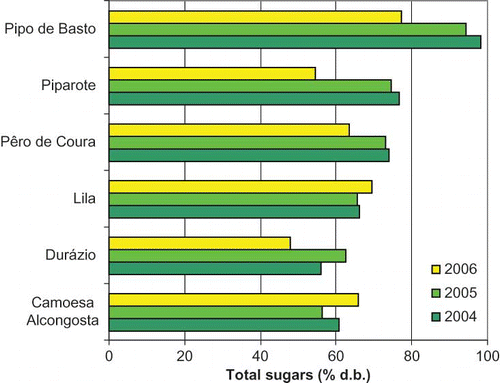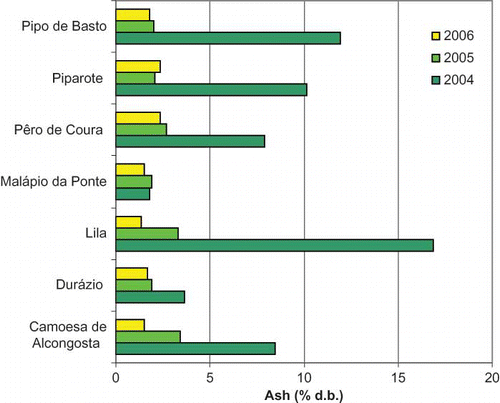Abstract
In the present study, apples of regional cultivars originating from Portugal were compared in terms of some chemical properties during three consecutive harvest years. It was possible to conclude that these regional cultivars of apples were generally sweeter and contained more minerals than other cultivars described in the literature. The data revealed that the acid, protein, and mineral content depended on the apple cultivar. The acid content varied notably with the 2004, 2005, and 2006 harvests. For total sugar or protein content, the variations observed were comparatively smaller. In the 2004 and 2005 harvests, the sugar and protein contents were similar but differ from the 2006 harvest. In respect to mineral content, the 2004 harvest registered the highest differences, and this was also the year when the apples had the highest maturation index, calculated as the sugar/acid ratio.
INTRODUCTION
Fruits have long been regarded as having considerable health benefits, particularly due to their antioxidant properties, which can protect the human body against cellular oxidation reactions (CitationPetkovsek et al., 2007).
Consumer expectations on food quality present the base for any successful food production and marketing. This is also true for fruits and vegetables, which are increasingly valued as an important part of the diet. In the past few years, evidence suggests that a regular consumption of fruits and vegetables may have an important role in preventing many diseases, for example, cardiovascular diseases and certain cancers, particularly of the digestive system. However, recently the WHO/FAO stated that the overall daily consumption of fruits and vegetables is 100 g underneath the recommended intake (CitationPéneaua et al., 2006). Therefore, it is of a great importance to promote the increase in the consumption of fruits, among which apples represent a good choice.
Sugars, phenolic compounds, and organic acids in fruits are important components that may be influenced by many factors: the species and cultivar within species, environmental and cultivation techniques, climatic conditions, growing seasons, storage conditions, and industrial processing (CitationChun et al., 2005; CitationPetkovsek et al., 2007).
In Portugal, many regional cultivars of apples can still be found, representing a genetic patrimony that must be preserved and promoted. Nevertheless, these regional cultivars are still of little commercial value because their potentialities are not identified and they are much less known to the consumers. Therefore, some work has been done in Portugal with the purpose of characterizing these cultivars to help promote them and to increase interest in cultivating and commercializing these cultivars.
In the present work, apples of regional cultivars originating from Portugal were studied with respect to some chemical attributes and the way they varied during 3 consecutive harvest years.
MATERIALS AND METHODS
In the present study, the following 17 regional cultivars of apples from Portugal were analyzed: 3 ao Prato da Covilhã, 3 ao Prato G10, Camoesa de Alcongosta, Camoesa de Magueja, Durázio, Lila, Malápio da Ponte, Malápio de Gouveia, Malápio do IFEC, Malápio Fino de Gouveia, Pardo Lindo do IFEC, Pássaros, Pêro de Coura, Pêro Rei Carrazeda, Piparote, Pipo de Basto, and Tromba de Boi. The apples were collected in an Orchard of the Agrarian Station of Viseu that belongs to the Minister for Agriculture, Rural Development and Fisheries.
For each type of analysis, only the pulp of the fruit was used, and two determinations were made in each case, except for acidity where three determinations were made. Moisture content of the pulp was determined by a halogen moisture analyzer (Mettler Toledo HG53, USA). The total and reducing sugar content, protein, and acidity was estimated according to established methodologies (CitationAssociation of Official Analytical Chemists [AOAC], 1990). Acidity was expressed in percentage of equivalents of malic acid, dry weight basis. The ash content was estimated by incineration at 550°C following the method from the CitationAOAC (1990).
RESULTS AND DISCUSSION
shows the acid content of 17 regional cultivars of apples in the 2004 harvest, expressed in equivalents of malic acid. The results reveal some important differences among the cultivars of apples, with the cultivars 3 Prato G10, Camoesa de Alcongosta, Lila, Pêro Rei Carrazeda, Piparote, and Tromba de Boi being less acidic, whereas Pardo Lindo do IFEC was the most acidic with a value four times higher than that of the less acidic cultivars (0.65 versus 0.16% malic acid, dry basis).
FIGURE 1 Acid content, expressed as malic acid (dry weight basis) of apples, from regional cultivars in the 2004 harvest.
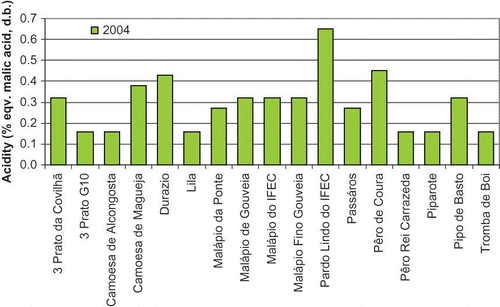
The graph in presents a global appreciation of the values of acidity for the different regional cultivars of apples, calculated as means over the 3 consecutive harvest years (2004, 2005, and 2006). The different cultivars were grouped by classes, according to their acid content. In this way, it was considered to be a low-acidity class up to 0.4% malic acid, a class of intermediate-acidity apples for values between 0.4 and 1.0% malic acid, and a class of high-acidity apples over 1.0% malic acid. The cultivar that had the lowest acid content was 3 Prato G10, and those that had the highest content were Malápio do IFEC and Piparote. The cultivar Malápio da Ponte with interesting organoleptic properties (CitationGuiné et al., 2008) is classified in the group of medium acidity, although it is close to the upper limit considered for this class.
FIGURE 2 Acid content, expressed as malic acid (dry weight basis), of apples from regional cultivars calculated as a mean values found over 2004, 2005, and 2006 harvests.
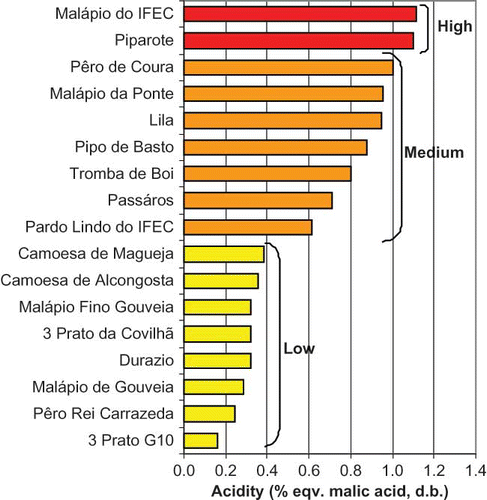
shows the acid content of some regional cultivars of apples, comparing the 2004, 2005, and 2006 harvests. The results denote great variations in the acidity of the apples during the 3 years of the study, in contrast to total sugars or protein where the variations were comparatively smaller.
FIGURE 3 Acid content, expressed as malic acid (dry weight basis), of apples from regional cultivars comparing three harvest years.
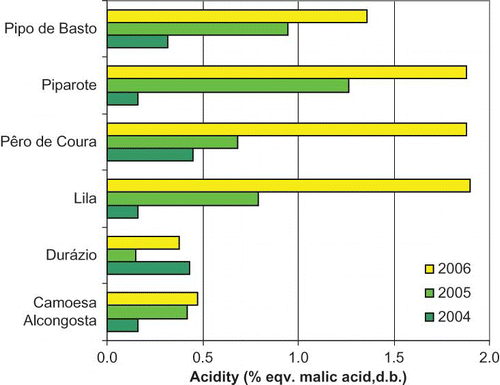
The total and reducing sugar content of the apples in the 2005 harvest is presented in . The sweetest cultivar is clearly Pipo de Basto, with a total sugar content of 96.3%, while the less sweet is Camoesa de Alcongosta with only 57.2%, which was also one of the less acidic cultivars of apples, as seen previously.
FIGURE 4 Sugar content, expressed on a dry weight basis, of apples from regional cultivars in the 2005 harvest.
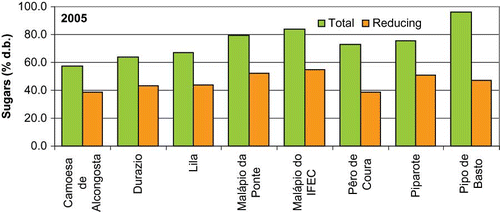
In , the different cultivars are grouped in classes according to their sweetness, calculated as a mean of total sugar content over the 2004, 2005, and 2006 harvests. The cultivars Malápio Fino de Gouveia, Pipo de Basto, and Malápio do IFEC were the sweetest, with total sugars contents above 80%. The cultivar Durázio was the only one in the class of low sweetness, under 60%, and all the other cultivars fell in the class of medium sweetness with contents between 60% and 80%. The cultivar Camoesa de Alcongosta was in the low sweetness category of 2005 () but averaged 60.9% over 3 years. Most of the regional cultivars, except Durázio and Camoesa de Alcongosta, had values for total sugar content higher than those described in the literature for total carbohydrate content of around 66% on a dry weight basis (CitationMartins et al., 2006). On the other hand, when expressed on wet weight basis (grams of total sugars per 100 g of fresh pulp), the least sweet regional cultivar had a value of 18% and the most sweet a value of 27%. Therefore, all the regional cultivars had higher sugar contents when compared to data found in the literature for apples such as the cultivar Aroma, which had total sugar contents of 9% expressed in wet weight basis (CitationNilsson and Kart-Erik, 2007).
FIGURE 5 Total sugar content of apples from regional cultivars, calculated as a mean of values, found over 2004, 2005, and 2006 harvests.
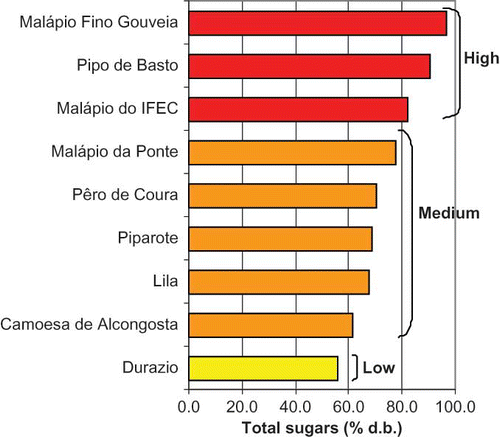
In , the total sugar content of apple pulp is presented for different regional cultivars comparing the 2004, 2005, and 2006 harvests. The results reveal that for the different cultivars in general, the total sugar content is very similar in the years 2004 and 2005, with 2006 being conspicuously different. From the graph, it is possible to observe that over the 3 years, the cultivar Pipo de Basto was the sweetest and the cultivars Durázio and Camoesa de Alcongosta were the least sweet. These results are in accordance with what was previously observed in and .
shows the maturation index (ripeness), calculated as the ratio between the total sugar and the acid content over 3 harvest years. The apples were considerably riper in the year 2004 for almost all cultivars, except for the cultivar Durázio, which was riper in the year 2005. As expected, the maturity stage is an essential factor determining the chemical composition of the apples and, in particular, the acid and sugar contents.
FIGURE 7 Maturation index, calculated as the sugar/acid ratio of apple pulp, from regional cultivars comparing 3 consecutive harvest years.
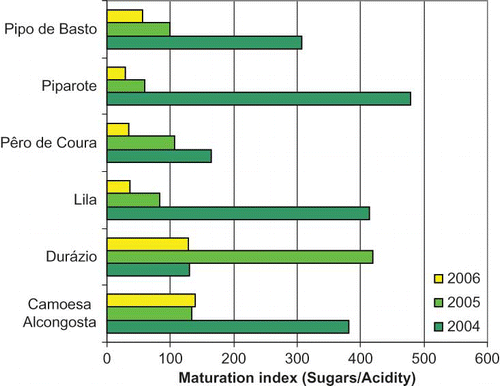
With respect to protein content, 3 Prato G10 had the highest value of protein content (1.59%), whereas 3 Prato da Covilhã and Camoesa de Magueja had the lowest values, with contents of 0.53% (). Globally, the values for protein content vary between 0.8% and 1.2%, which is in accordance with the value found in the literature for apple pulp (1%) expressed in dry basis (CitationMartins et al., 2006).
FIGURE 8 Protein content, expressed on a dry weight basis, of apples from regional cultivars in the 2004 harvest.
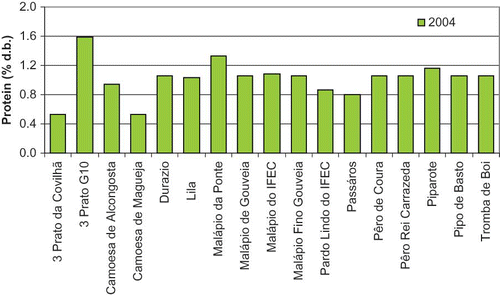
The mean protein content over the 3 harvest years, grouped in three classes, using the same methodology described above, is shown in . The cultivars 3 Prato G10 and Malápio da Ponte fall into the high-protein class with contents over 1.2%, and the cultivars in the low-protein class are Pássaros, Camoesa de Magueja, and 3 Prato Covilhã, with contents under 0.8%.
FIGURE 9 Protein content of apple from regional cultivars, calculated as a mean of values, found over 2004, 2005, and 2006 harvests.
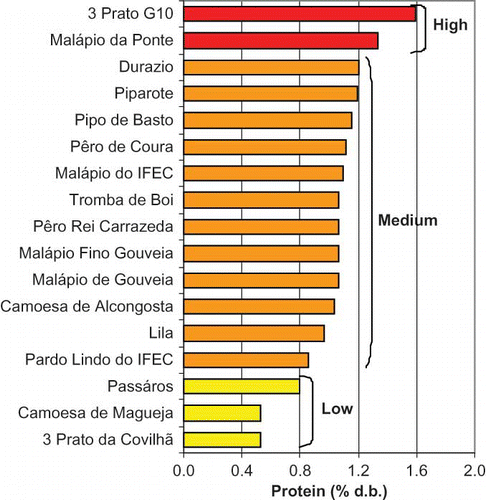
The variation of protein content with the harvest year is shown in . The protein content in the years 2004 and 2005 are very similar among cultivars. For Piparote and Lila cultivars, the protein content is approximately similar in the 3 harvest years, but for others cultivars, such as Pipo de Basto, Pêro de Coura, Durázio, and Camoesa de Alcongosta, the protein content is clearly higher in the 2006 harvest.
shows the moisture content of the apples in the 2006 harvest. The values vary between 80% for the cultivar Pardo Lindo do IFEC and 85% for the cultivars Camoesa de Alcongosta, Malápio da Ponte, Pêro de Coura, and Piparote.
FIGURE 11 Moisture content, expressed on a wet weight basis, of apples from regional cultivars in the 2006 harvest.

The ash content of the apples in the 2006 harvest is presented in . Pardo Lindo do IFEC is distinguished from the others because of its high content (above 3%). A high percentage of ash gives an indication of a high content in minerals, which is important in nutritional terms.
FIGURE 12 Ash content, expressed on a dry weight basis, of apples from regional cultivars in the 2006 harvest.
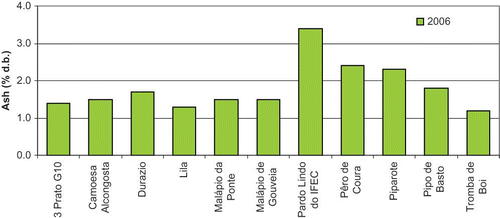
The medium ash content over the 3 harvest years, grouped in three classes, using the methodology described above, is shown in . The ash content expressed in dry basis is high for values above 3%, medium for values between 2% and 3%, and low for values under 2%. The cultivars richest in minerals were Malápio fino de Gouveia, Pardo Lindo do IFEC, 3 Prato da Covilhã, and Pássaros. Globally, the values of ash content vary between 1.5% and 3.9%, which are almost all higher than the 1.6% found in the literature for the pulp of six cultivars of apples (CitationMartins et al., 2006). The only exception was the cultivar Malápio de Gouveia.
FIGURE 13 Ash content of apples from regional cultivars, calculated as mean values found over 2004, 2005, and 2006 harvests.
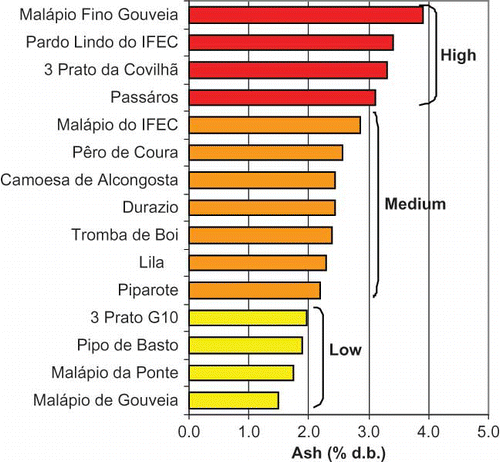
The variations of the ash contents over the three harvest years of 2004, 2005, and 2006 are presented in . It is possible to observe that in the years 2005 and 2006, the contents are similar for all cultivars, whereas in 2004, the apples of all cultivars present much higher mineral contents. These results may be very much related to the cultural operations done in the orchard and, in particular, the utilization of soil fertilizers.
CONCLUSIONS
From the regional cultivars of apples analyzed over the 3 harvest years of 2004, 2005, and 2006, the cultivar that had the lowest acid content was 3 Prato G10 and those that had the highest values were Malápio do IFEC and Piparote.
The sweetest cultivars were Malápio Fino de Gouveia, Pipo de Basto, and Malápio do IFEC, while the cultivar Durázio was the least sweet. Furthermore, these cultivars are, in general terms, sweeter when compared to other cultivars cited in literature.
The cultivars richest in proteins were 3 Prato G10 and Malápio da Ponte, and the ones with the lowest content were Pássaros, Camoesa de Magueja, and 3 Prato Covilhã.
Almost all the cultivars studied had very high mineral content values as estimated by ash measurements compared to other cultivars cited in the literature. The cultivars Malápio fino de Gouveia, Pardo Lindo do IFEC, 3 Prato da Covilhã, and Pássaros had the highest values.
It was also possible to observe that the acid content of the apples varied greatly between the 2004, 2005, and 2006 harvests, whereas total sugar or protein content had comparatively smaller variations. In the years 2004 and 2005, the sugar and protein contents are similar, but in 2006, the cultivars show greater differences. In contrast, the ash content showed the greatest differences in 2004. Also, this year was the one when the apples had the highest maturation index, calculated as the sugar/acid ratio.
LITERATURE CITED
- Association of Official Analytical Chemists (AOAC) . 1990 . Official methods of analysis , 15th , Arlington, VA : AOAC .
- Chun , O.K. , Kim , D.O. , Smith , N. , Schroeder , D. , Han , J.T. and Lee , C.Y. 2005 . Daily consumption of phenolics and total antioxidant capacity from fruit and vegetables in the American diet . J. Sci. Food Agr. , 85 : 1715 – 1724 .
- Guiné , R. , Correia , A.C. , Jordão , A. and Ferreira , D. 2008 . “ Avaliação nutricional e sensorial de variedades regionais de pomóideas, em modo de produção convencional e biológico ” . In Variedades regionais e agricultura biológica, desafios para peras e maças Portuguesas , Edited by: Sim[otilde]es , O. , Lopes , A. and Ferreira , J. 134 – 147 . Coimbra : ESAC/DRAPC .
- Martins , I. , Porto , A. and Oliveira , L. 2006 . Tabela da composição de alimentos , 96 – 97 . Instituto Nacional de Saúde Dr. Ricardo Jorge .
- Nilsson , T. and Kart-Erik , G. 2007 . Postharvest physiology of “Aroma” apples in relation to position on the tree. Postharv . Biol. Technol. , 43 : 36 – 46 .
- Péneaua , S. , Hoehnb , E. , Rothc , H.R. , Eschera , F. and Nuesslia , J. 2006 . Importance and consumer perception of freshness of apples . Food Qual. Pref. , 17 ( 1–2 ) : 9 – 19 .
- Petkovsek , M.M. , Stampara , F. and Veberic , R. 2007 . Parameters of inner quality of the apple scab resistant and susceptible apple cultivars (Malus domestica Borkh.) . Sci. Hort. , 114 ( 1 ) : 37 – 44 .
